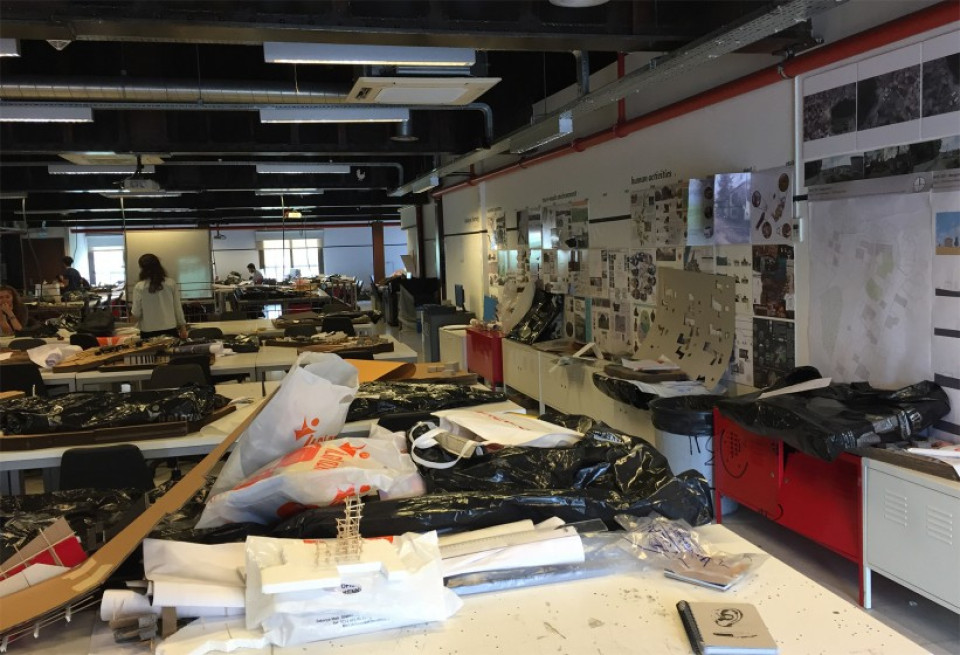Is Creativity the Goal?
“Learn as much as it is needed, overdoing it kills creativity. Take the time to think as well to read.” Aziz Sancar
“The value of a college education is not the learning of many facts but the training of the mind to think.”
Albert Einstein
Architecture is a beautiful art, an art of creating spaces; it produces new works of art. The works it creates are preserved, as long as the world stands, by copyright claims. That point of view still reigns, but for us, it is the remnant of a time back when the architect was one of the king’s jesters. Lot of water passed under the bridge. Today’s architect has a responsibility to the common man; to the society and to nature. Let’s go back to the beginning of the story.

How were the architect and the apprentice chosen in those days to build palaces, churches and mansions? Was there an entrance exam for the guilds? Was there any creativity at the guilds? The guilds’ job was to monitor the practices in their respective fields. The guilds used to keep and control occupational secrets that formed through traditions. By freezing quality to death and destroying the creativity, the guilds were the natural results of this monopolistic system. Moreover, the obligation of membership into the guilds allowed the masters never to share the cake, and to be provided with years and years of labor from apprentices, and then three more years from journeymen, for very little pay. A quick note here—young architects today should always keep that in mind.
The French Revolution ended the guilds to allow for unconditional working opportunities to the “individual”, whose worth and freedom had then just been recognized. The fact that this further helped the advancement of the capitalism by reducing the service fees, with the guilds also serving the bourgeois (the capitalist), gave way to complicated circumstances.
Today, the license examinations in Anglo-Saxon countries for trade associations should not be revered; they should instead be seen as the resurrection of the guild system. Architecture in our country is also currently under the threat of the license examination from trade associations. The trade associations, with a hold on current practices, never aimed to foster creativity in the past, and will not do so in the future. For us, the goal is delaying the sharing of the cake. Taking a year to work at an office after your third year of education and to return afterwards to finish up, is just like the journeyman’s three years of going around in the guild. We often encounter advices favoring bringing on this practice; due to its application in certain foreign countries today. We can understand why the trade associations are showing support for this; but it is impossible to comprehend why the schools are behind it as well.
Architecture is transforming and becoming more complex according to relevant social developments, as well as changing interests – or according to some, the changing service areas. As the process begins with the fast overtaking of schooling, occurring in line with Enlightenment, the system picks the student to educate according to whatever’s considered “architecture” at the time…
By the end of a century, fine arts academies were organizing “drawing” exams in order to choose the people whom they would teach the “fine” and “stylized” art of architecture—to pass on the secrets of the profession. Architecture was taken as a fine art; it was taken to be about good drawing skills. Architecture was the beautiful drawing: the image of the front facade, the dictated image of the front facade with its well-defined beauty. The lack of need for creativity in the elite-style architecture presented a contradiction when the drawing exams where students were admitted by their creativity were considered. Demanding of this situation to continue constituted a problem of near unconsciousness. With that in mind, even 200 years ago, there were also people who interpreted creativity as the use of intelligence rather than the ability to draw.
Developing in the same years were the “polytechnic” schools; these schools were accepting architecture students through difficult tests on physics, math and even chemistry, with the intention of teaching them not the rules of constituted artificial beauty, but instead to educate them to be the brains that would solve the unpredictable kind of problems that were to occur in the unclear and unsteady future. It should be noted that science exams do not test whether the student knows formulas or theorems, but whether he or she can establish links and relations to reach solutions. There existed between the architecture defined by “the fine arts school” and “the engineering school” such a significant contrast.
What is creativity? Does creativity exist only in fine arts? Is it only needed in architecture? Isn’t there creativity in physical sciences, math or even literature? Or do all physicists and mathematician also draw very well? What is crucial is what we understand from the creativity. Does creativity mean producing in accordance with an artificial and temporary definition of beauty? In other words, is it the ability to make good copies? Or is it the ability to produce something that excites the human mind? (Mollaahmetoğlu) Is it mathematics when you solve a problem through pages and pages of calculations, or when you form a smart link between one or two relations?
It was groundless and even ridiculous to place high school students in Turkey in separate divisions of science or literature. No one ever questioned how students simply trying to avoid math would cope with literature’s complex structure. Can today’s lawless environment be a result of years and years of students being admitted to law schools without examinations? The differences among today’s architectural schools are not that sharp; as the presiding attitude is to give only some of the secrets of the ongoing “work.” What does it mean, then, to be an architect? Is it enough for the education – and the creative education – to finalize the educational program in any way necessary, keeping in mind the existing definition of the architect, and to choose the students accordingly? Maybe we should also question whether or not it’s really required to do so... Are there students who enter the schools with really high test scores, set to be really good architects, but end up quitting after their very first year when they encounter an educator(!) who declares to them, “Give up, you cannot be an architect”? Likewise, are there students who finish their schools with the highest grades but still do not want to become an architect? Don’t the educators have a role in how both good and bad architects are raised among the same group of students who have the same scores but are trained by different academicians? Is the student labeled as “bad” really bad, or has she or he been made bad? There are so many questions, defects and contradictions...
In summary, good education is not only about accepting students who fit in the appropriate program. The key is the educators. “The crucial point of the problem is determining the educational program. The adopted attitude should be trying to make the students pose questions within themselves of scientific and academic nature, and to break the solid and frigid frame of the curriculum... Dynamism in education can be realized only in as much as the educator is open to ideas and practices beyond his own experience,” Aptullah Kuran said in 1969. By claiming “imagination is more important than knowledge,” Einstein also pointed at the same phenomenon: the educator is tasked to activate the “imagination.”
In our opinion, the main affliction of architectural education today is the Bauhaus legacy; the Bauhaus legacy that should have been rejected, but instead has been applied unquestionably and irresponsibly. We are forcing in our education the Bauhaus understanding, 100 years later, on students we admitted through science exams. Two terrible things we have inherited: first of all the idea that “you can’t move on to design without first taking on technical knowledge and basic design principles”, which we consider to be nothing but an attempt by Bauhaus to form a style; and second, believing that “education proceeds through a master-apprentice relationship.” We are applying these principles without questioning how Bauhaus, refusing history but taking on a system of apprenticeship, including journeymen, found a master. The education programs of most of the schools in Turkey still consist of first-year classes filled with technical information (Neufert) and basic design principles. This legacy is causing damage; and we must leave it behind. This legacy is binding our hands so tight that there exist people among us who believe that “you should not give a multiple-stories building project to students who haven’t yet learned about stairs.”
Kuran explains that the main idea of Bauhaus was the need for a compromise between the human creative power and the industrial production; and that this was the only way to reach towards the contemporary form principles and architectural perception; and therefore academies should progress to form from material and basic principles, rather than starting from it. Kuran also in vain attempts to remind everyone that architectural education and practices were kept in the background at the Bauhaus School.
So choosing the student and getting the education program right takes you only so far. Instead of insisting on the “master and apprentice” relation; we should see that the fundamental aspect that allows the student to reach creativity is “the openness of the educator to the ideas and practices beyond his experience.” Even though there are only few of such educators, you can always see the results in institutions where they reside. Then again, we cannot say that creativity is being pursued when schools and competitions bring to forefront ordinary projects with appealing “renders.” At the very best, all we can expect is the emergence and the taking over of the opinion that claims “people who are good at digital modeling should be admitted to an education in architecture.”
References:
-Kuran, Aptullah. Mimarlık Eğitimi Üzerine. Mimarlık. Issue 9, p. 19-20. 1971
-Mollaahmetoğlu, İrem. Bakterili Mimarlık. Arredamento Mimarlık. p. 119-127. Sept, 2015.
Related Content:
-
10 Tips For A Successful Architectural Design Studio
Has architectural education become such a know-how package that is transmitted through such documents only?
-
Inhabiting the Earth in Symbiosis with the Environment
Aixopluc takes on the challenge to find new modes of inhabitation in symbiosis with planet earth
-
Tactical Spatial Experiments in the Studio
Going up against the present “strategies” of architecture that feed on the cooperation between property, global capital and power, Asiye Akgün Gültekin and Erdem Üngür are searching for “tactics” through which architecture may seek the absence of space and power. The following text explores how they deal with the process in the architecture studio
 07.03.2016
07.03.2016







